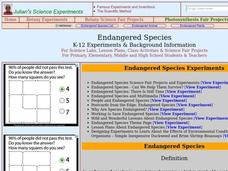Curated OER
Blue Planet: Tidal Seas
Students investigate how tides affect sea life. In this video based lesson, students view a video on how tides affect sea life. They do web-based research to find the answers to a series of questions and then play Tidal Trivia to test...
Curated OER
Life Cycle: Diversity in a Balance
In this life cycle workbook, 3rd graders complete several different activities in which they analyze different invertebrates, identify arthropods, examine human biology and plants, and study natural environments. 20 different activities...
Curated OER
Which Part of the Great Salt Lake Stinks More?
Students research background knowledge of the Great Salt Lake prior to a field trip. They identify specific wild life at the Great Salt Lake on the field trip and identify the islands in the Great Salt Lake. They present their...
Curated OER
Postcard to Mom
Students research the stages a lobster larvae passes through. in this lobster instructional activity, students pretend as if they are the lobster larvae and write a postcard to their lobster mother describing the changes they have been...
Curated OER
Populations and Life Cycles
Students explore biology by researching ocean statistics. In this data analysis instructional activity, students conduct a snail examination experiment utilizing live pouch snails. Students collect data about the snails over the course...
Curated OER
Endangered Species
Students create a postcard about endangered species. For this biology lesson, students identify how human activities endanger other species. They research and recommend ways to help protect them.
Curated OER
LD50 of NaCl to Gammarus spp.
Students learn the meaning of LD50 through lecture and discussion. Through experiment, students graph and calculate the LD50 of salt on fresh water amphipods. Students compare results of the experiment with pesticides and pollutants.
Curated OER
How Hot is Too Hot?
Fifth graders use the scientific method to conduct experiments on the temperature effects on organisms. In this temperature effects on organisms lesson plan, 5th graders observe and record the hatching or the developing of organisms into...
Curated OER
Oolitic Sand: An Introduction
Fourth graders investigate the characteristics of different types of sand. They compare and contrast the types of sand by making observations with a dissecting microscope. Then students draw what is seen and include shape, color, and...
Curated OER
Barnacles: Harder than Cement
Fourth graders watch the movements of the complex animal hidden inside the tiny barnacle shells. This lesson allows students to study the behavior, adaptation, and larval stage of the barnacle.
Curated OER
Comparative Embryology Using Japanese Medaka Fish
Students conduct an experiment to control the breeding of Japanese Medaka fish. They collect the fertilized eggs and view and record the fish's embryological development daily to compare the stages to human development.
Curated OER
Which Sand Contains The Most Salt?
Students investigate the salinity levels of sand samples taken from several different sources. They conduct tests and observations to measure the current salt levels. They develop a hypothesis from the experiment to determine the factors...
Other popular searches
- Brine Shrimp Experiment
- Salinity Brine Shrimp
- Brine Shrimp Movement
- Observation of Brine Shrimp
- Salt Affect Brine Shrimp
- Anatomy Brine Shrimp
- Brine Shrimp Phototaxis
- Brine Shrimp Light
- Obserevation of Brine Shrimp
- Brine Shrimp Projects
- Brine Shrimp Life Cycle
- Brine Shrimp Photo Taxis













